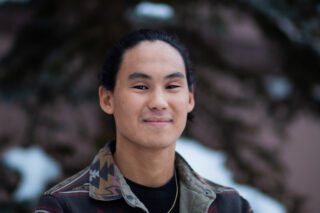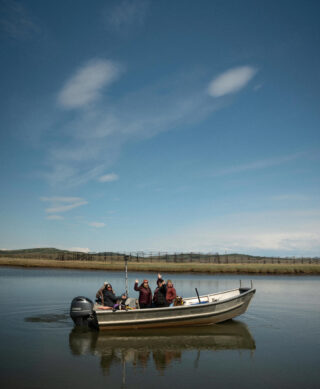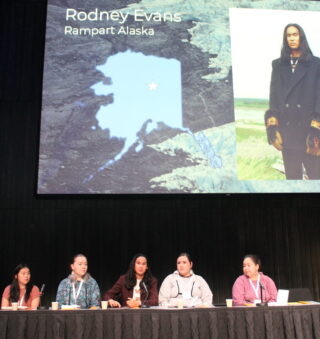In Alaska, many villages, especially those off the road system, are grappling with the far-reaching effects of climate change, including erosion, wildfires, flooding, and thawing permafrost. These challenges are felt most acutely by Alaska Native communities, whose traditional ways of life—closely tied to the land and water—are increasingly threatened. In Rampart, a remote village of 60 people, where access is limited to planes, boats, or snowmachines, these issues are hitting home. Rodney Evans, an Arctic Youth Ambassador (AYA) from Rampart, is witnessing firsthand the rapid changes to the Arctic climate and how they are reshaping life for those who depend on the land. Increased lightning storms, unpredictable winters, and extreme weather events are taking a toll on local wildlife and the community’s way of life.

“In these communities, we rely on traditional knowledge to hunt and fish for survival,” Rodney explains, underscoring how climate change threatens the wildlife and landscapes vital to these practices. Dwindling salmon populations and shrinking caribou habitats are among the most urgent issues. “These animals aren’t just our food; they have defined us as people for generations,” Rodney adds.
The challenges Rodney describes are interconnected, highlighting how climate change impacts every facet of life in rural Alaska. Through the Arctic Youth Ambassadors (AYA) program, Rodney has found an avenue to share his community’s story, advocate for the land, and raise awareness about the climate crisis that threatens both the environment and traditional ways of life.

The AYA program offers young leaders platforms to share their experiences in their communities while highlighting issues they are passionate about, offering youth the chance to step into influential spaces and develop essential communication and public speaking skills. “The AYA
program has helped me speak on panels and gain experience sharing my community’s stories. These opportunities wouldn’t have been possible without AYA,” Rodney reflects.
By investing in youth leadership, the AYA program ensures that Arctic communities are represented in critical discussions about climate change and decisions about the environment. It equips young leaders like Rodney with the tools and opportunities they need to address pressing issues, such as food security and sustainable energy, and to share their expertise with those who make decisions that will shape the future of the Arctic.
However, stepping into spaces that aren’t always designed for Indigenous youth comes with its challenges. Rodney acknowledges the discomfort of navigating environments that can feel extractive or harmful. “These spaces weren’t originally created for us, and they can sometimes feel harmful, extractive, or even exploitative,” he says. “There’s a push for youth to take the stage, but it’s important to ensure we’re taken care of—especially our mental health and well-being.”

Despite working within systems that weren’t created with them in mind, the fourth AYA cohort demonstrated remarkable resilience and drive. One of their most notable achievements was securing a million-dollar grant through the Denali Commission. This project aims to support coastal communities that are affected by disasters like Typhoon Merbok, with an emphasis on local knowledge and storytelling. The project explores how communities have passed down their traditions even in the face of climate change and natural disasters. Rodney and his peers traveled to affected communities, interviewing residents and capturing their stories through photography and filmmaking. The final goal of the project is to raise awareness about storm preparedness and show how communities are navigating the challenges posed by environmental shifts by highlighting the knowledge and histories of the communities.
Rodney also highlighted how rewarding it has been to work with a wide range of organizations. The AYA program partners with agencies like the US Fish and Wildlife Service and the World Wildlife Fund, providing internships and job opportunities. After 18 months, the fourth Arctic Youth Ambassadors cohort culminated with a retreat and ceremony in Sitka, where Rodney and his peers reflected on their journey and celebrated their growth. “So many of us wouldn’t be here if it weren’t for this program and the chance to share our stories and be voices for our communities,” Rodney shared. The program demonstrates the ability of Alaskan youth to drive meaningful change. As climate change reshapes the Arctic, these young leaders will play a critical role in ensuring that rural communities and Tribes help shape a sustainable future.


